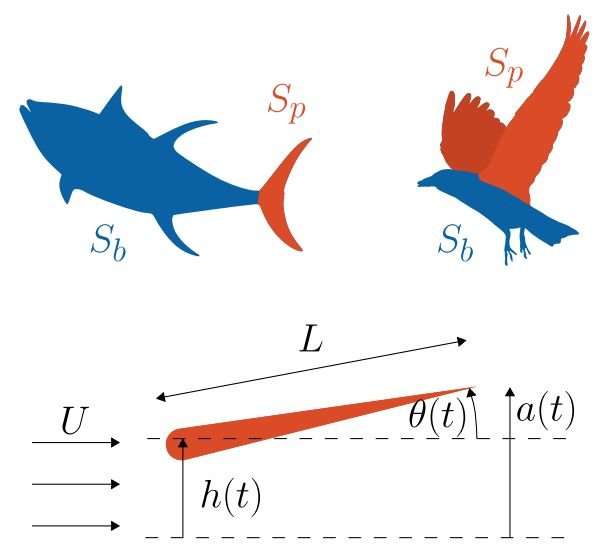June 29, 2018 report
How evolution builds the most efficient airfoils

Swimming and flying animals are optimally adapted for cruising through their environments, producing thrust via propulsors—wings for birds and caudal fins for fish. Over millions of years, the morphology of these animals evolved for maximally efficient cruising, and about 30 years ago, researchers proposed that most swimmers cruise within a narrow range of Strouhal numbers—these are dimensionless numbers describing oscillating flow. And more recently, researchers determined that flying animals cruise in the same range of Strouhal numbers.
Specifically, for swimming and flying animals, the Strouhal number is defined as St=f / U*A, where f is the oscillation frequency, U is the flow rate, and A is the oscillation amplitude. And the narrow range of Strouhal numbers in which swimming and flying animals cruise is 0.2 < St < 0.4.
OK. So why is this narrow range of numbers the most efficient? Daniel Floryan, Tyler Van Buren and Alexander J. Smits, mechanical engineers at Princeton University, conducted a study into the efficiency of swimming and flying animals in order to answer that question.
They used an experimental setup derived from earlier studies, which consisted of an airfoil in a water tunnel. The airfoil made biologically relevant heaving and pitching motions that were measured by encoders. The researchers performed experiments over all possible combinations of kinetic parameters and analyzed the resulting data mathematically.
Since drag can never be completely eliminated, perfect efficiency is not possible. But the animals selected as the fittest have evolved to a narrow range of highly efficient parameters.
A swimming animal at a constant velocity creates thrust with its caudal fin, and experiences drag produced by two sources: its body, and the "offset" drag caused by the propulsor frontal area projected over its range of motion.
For flying animals, the physics are somewhat different since their propulsors need to resist gravity in addition to providing thrust. However, the need to produce lift doesn't affect the physics of propulsion and drag when the animal is at a steady cruising speed.
In previous studies, researchers suggested that large-amplitude motions set the Strouhal number for efficient cruising. The authors of the current study argue that the amplitude sets the total efficiency without dictating the optimal Strouhal number. Instead, the authors write, "the offset drag is crucial in determining the low Strouhal behavior and setting the particular Strouhal at which peak efficiency occurs."
Drag turns out to be key. Based on their analysis, the researchers conclude that the range of Strouhal numbers that defines highly efficient cruising for swimming and flying animals is largely determined by the fluid drag on fins and wings. "In other words," the authors conclude, "energetic considerations set the kinematics of the propulsor to the most efficient one, and the net thrust of the propulsor at peak efficiency balances the drag of the body to set the cruising speed."
More information: Daniel Floryan et al. Efficient cruising for swimming and flying animals is dictated by fluid drag, Proceedings of the National Academy of Sciences (2018). DOI: 10.1073/pnas.1805941115
Abstract
Many swimming and flying animals are observed to cruise in a narrow range of Strouhal numbers, where the Strouhal number St=2fA/USt=2fA/U is a dimensionless parameter that relates stroke frequency f, amplitude A, and forward speed U. Dolphins, sharks, bony fish, birds, bats, and insects typically cruise in the range 0.2
Journal information: Proceedings of the National Academy of Sciences
© 2018 Phys.org



















